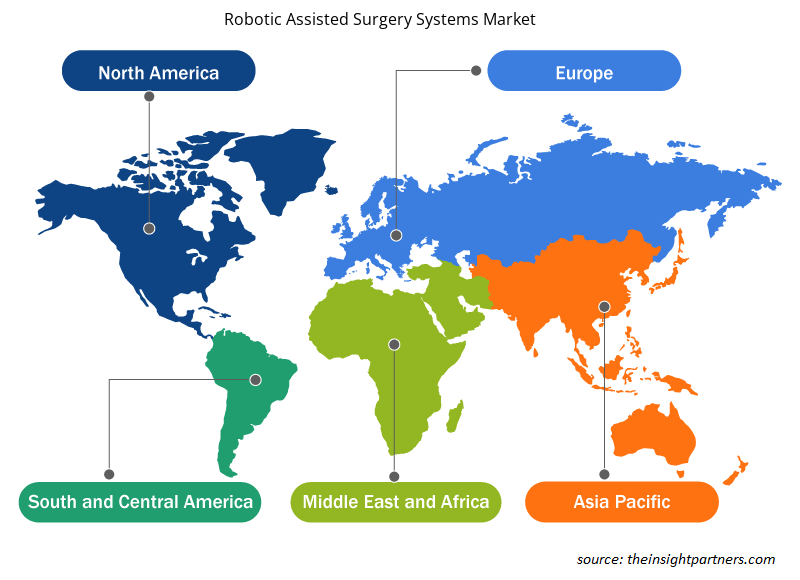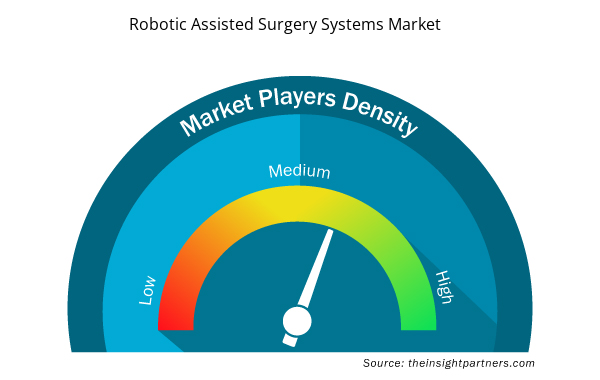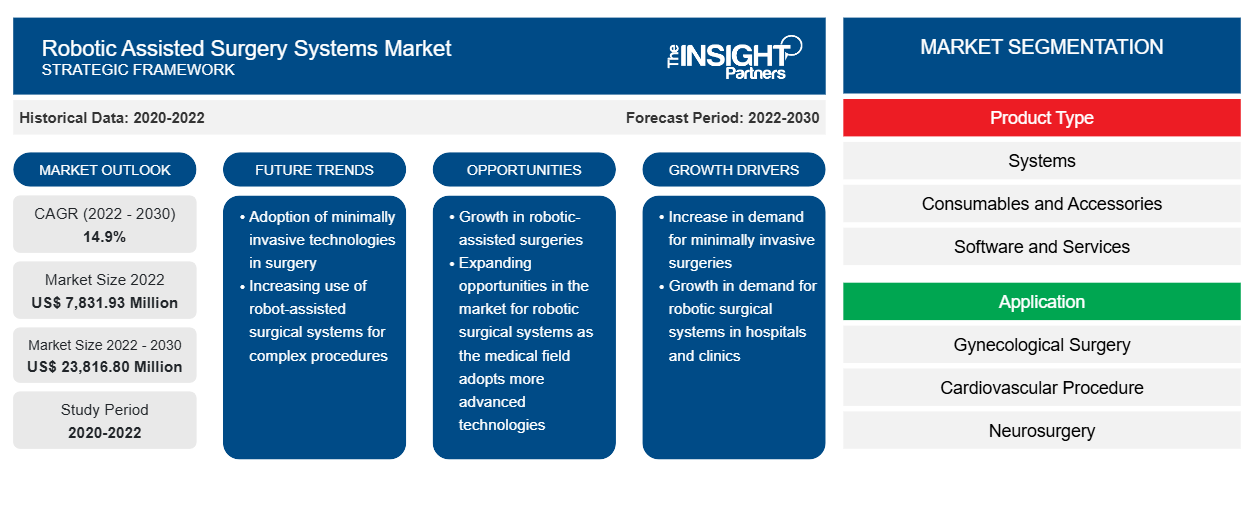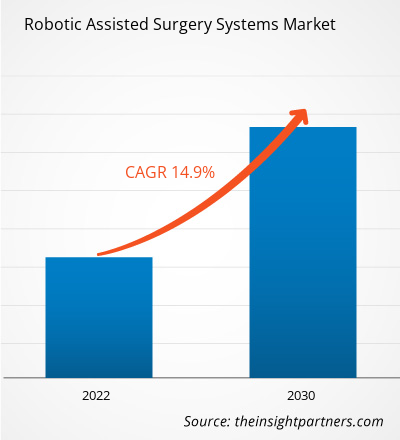[研究报告] 机器人辅助手术系统市场规模预计将从 2022 年的 78.3193 亿美元增长到 2030 年的 238.168 亿美元;预计 2022 年至 2030 年市场复合年增长率为 14.9%。
市场洞察和分析师观点:
机器人辅助手术系统市场涵盖一系列技术先进的手术平台,这些平台集成了机器人、成像和导航系统,可帮助外科医生以更高的精度和控制力执行微创手术。这些系统旨在增强手术能力、改善患者治疗效果并最大限度地减少传统手术技术的侵入性。机器人辅助手术系统值得注意的好处包括增强的灵活性、三维可视化和震颤过滤,使外科医生能够以卓越的准确性和可操作性执行复杂的手术。这些系统通常使他们能够进入难以到达的解剖区域,从而减少创伤并加快患者的恢复时间。此外,将机器人技术集成到手术中可最大限度地降低并发症的风险并降低输血需求,最终有助于改善术后效果。
增长动力和挑战:
越来越多的研究探索机器人辅助手术的优势和能力,预计将在未来几年推动市场进步。 2022 年 9 月,名古屋市立大学 (NCU) 医学研究生院的一个团队进行了一项研究,比较了机器人辅助、荧光透视引导、超声引导的经皮肾镜取石术肾通路。 该研究结果证明了革命性的机器人设备的安全性和易用性,这可能会减轻外科医生的培训负担,并使更多医院能够执行 PCNL 手术。 这种使用人工智能驱动的机器人技术的方法可能为类似手术干预的自动化打开大门,从而加快流程并降低并发症的风险。
慢性病病例的增加和微创手术的日益普及进一步利好机器人辅助手术系统市场。据《印度教徒报》 2022 年 8 月发布的消息,印度海得拉巴的阿波罗健康城已完成 500 多例机器人辅助妇科手术。2022 年 11 月,美敦力公司的全资子公司印度美敦力私人有限公司和德里的 Venkateshwar 医院宣布使用 Hugo 机器人辅助手术 (RAS) 系统完成了印度北部首例泌尿科治疗。
另一方面,机器人手术系统的高成本妨碍了医疗服务提供者的财务可行性和运营可持续性。虽然这些系统具有提高精度、微创和缩短患者恢复时间等优势,但大量的前期投资和持续的维护成本需要医疗机构进行仔细的财务规划和资源分配。此外,手术人员需要接受专门的培训和认证才能操作这些系统,这进一步增加了运营成本,影响了将机器人手术整合到现有临床实践中的整体可负担性和实用性。与机器人手术系统相关的成本负担可能会影响医疗报销模式和承保决策。使用机器人辅助进行的手术的报销率可能有所不同,保险提供商的承保范围可能会影响采用这些技术的经济理由。这造成了一个复杂的局面,医疗机构需要权衡机器人手术的临床优势与财务影响,这可能会影响不同医疗系统的采用速度和规模。
定制此报告以满足您的需求
您可以免费定制任何报告,包括本报告的部分内容、国家级分析、Excel 数据包,以及为初创企业和大学提供优惠和折扣
- 获取此报告的关键市场趋势。这个免费样品将包括数据分析,从市场趋势到估计和预测。
报告细分和范围:
机器人辅助手术系统市场根据产品类型、应用和最终用户进行细分。根据产品类型,市场分为系统、仪器和配件以及服务。根据应用,机器人辅助手术系统市场细分为妇科手术、心血管、神经外科、骨科手术、腹腔镜检查、泌尿科、普通外科等。根据最终用户,市场分为医院、门诊手术中心和其他最终用户。在地理方面,机器人辅助手术系统市场分为北美(美国、加拿大和墨西哥)、欧洲(英国、德国、法国、意大利、西班牙和欧洲其他地区)、亚太地区(中国、日本、印度、韩国、澳大利亚和亚太地区其他地区)、中东和非洲(阿联酋、沙特阿拉伯、南非和中东和非洲其他地区)以及南美洲和中美洲(巴西、阿根廷和南美洲和中美洲其他地区)。
节段分析:
根据产品类型,手术机器人部分在 2022 年占据了机器人辅助手术系统市场的很大收入份额。由于全球心血管和癌症发病率激增,预计对执行精确和准确手术的手术机器人的需求将会增加。根据美国癌症协会的《2023 年癌症统计数据》,预计美国将在 2023 年报告 190 万例新癌症病例。根据澳大利亚卫生和福利研究所 (AIHW) 2021 年的报告,2021 年澳大利亚估计新增癌症病例为 150,800 例。澳大利亚统计局 2022 年 3 月的报告指出,估计 2021 年 4.0% 的澳大利亚人(即 100 万人)患有心脏病。
根据应用,机器人辅助手术系统市场分为妇科手术、心血管手术、神经外科、骨科手术、腹腔镜手术、泌尿外科、普通外科等。预计神经科领域将在 2022-2030 年期间录得最快的复合年增长率。手术机器人在普通手术中的使用越来越多,并且它们比传统手术方法具有优势,这将使整个市场受益。此外,技术的进步和机器人神经外科手术的成功结果预计将在未来几年推动机器人辅助手术系统市场的扩张。根据 SS Innovations Interventional Inc. 的数据,2020 年全球进行了约 160 万例机器人手术。
根据最终用户,机器人辅助手术系统市场细分为医院、门诊手术中心和其他最终用户。医院部门在 2022 年占据了市场主导地位,预计在 2022-2030 年期间将实现高复合年增长率。医院部门市场的增长归因于多个经济体医疗成本的上升。医院利用最新的机器人辅助手术设备提供优质的护理。此外,医生和外科医生更喜欢机器人辅助系统。根据 JAMA 网络发表的一篇论文,机器人辅助手术在整体外科手术中的使用率从 2013 年的 1.8% 激增至 2019 年的 15.1%,增幅达数倍。
区域分析:
根据地理位置,机器人辅助手术系统市场分为北美、欧洲、亚太地区、中东和非洲以及南美和中美洲。北美是该市场增长的最大贡献者。该地区的市场进步归因于美国自动手术器械的使用日益增多以及下一代医疗保健系统的采用。此外,与患者群体相比,美国外科医生和医疗专业人员的缺乏预计将使机器人辅助手术系统市场受益。糖尿病、癌症和心血管疾病等慢性病患病率的增加推动了美国对机器人辅助手术系统的需求。
与传统手术相比,微创手术越来越受欢迎,这有利于机器人辅助手术系统市场。据美敦力公司称,2022 年 12 月,Hugo 在美国招募了第一位患者,扩大了其机器人辅助手术 (RAS) 系统的临床试验。此外,2022 年,北卡罗来纳州达勒姆市杜克大学医院的一名医生进行了机器人辅助前列腺切除术。
由于患者人数不断增加以及先进自动化手术器械的使用日益增多,预计亚太地区机器人辅助手术系统市场将在 2022-2030 年期间以最快的复合年增长率增长。此外,预计未来该地区市场的增长将受益于现代医疗设施的扩大和公众对尖端医疗技术优势的认识提高。亚太各国政府正在尝试建立先进的医疗保健基础设施,这吸引了国际企业在该地区投资建立自动化器械开发设施。中国在亚太地区的机器人辅助手术系统市场中占有最大份额,预计印度将在 2022-2030 年期间创下最高复合年增长率。中国从事手术机器人业务的公司利用特殊的审批途径缩短了上市时间,该途径加快了创新医疗产品的监管审批。此外,越来越多的专门从事手术机器人的医疗技术公司正在中国涌现。近年来,健嘉机器人和 Hurwa 进入中国市场,与国内专门从事骨科手术机器人研发的 TINAVI 公司共同开发手术机器人解决方案。北京为 TINAVI 机器人辅助的脊柱、髋关节和膝关节手术提供报销。
机器人辅助手术系统市场区域洞察
Insight Partners 的分析师已详细解释了预测期内影响机器人辅助手术系统市场的区域趋势和因素。本节还讨论了北美、欧洲、亚太地区、中东和非洲以及南美和中美洲的机器人辅助手术系统市场细分和地理位置。

- 获取机器人辅助手术系统市场的区域特定数据
机器人辅助手术系统市场报告范围
| 报告属性 | 细节 |
|---|---|
| 2022 年市场规模 | 78.3193亿美元 |
| 2030 年的市场规模 | 238.168 亿美元 |
| 全球复合年增长率(2022 - 2030 年) | 14.9% |
| 史料 | 2020-2022 |
| 预测期 | 2022-2030 |
| 涵盖的领域 | 按产品类型
|
| 覆盖地区和国家 | 北美
|
| 市场领导者和主要公司简介 |
|
机器人辅助手术系统市场参与者密度:了解其对业务动态的影响
机器人辅助手术系统市场正在快速增长,这得益于终端用户需求的不断增长,这些需求源于消费者偏好的不断变化、技术进步以及对产品优势的认识不断提高等因素。随着需求的增加,企业正在扩大其产品范围,进行创新以满足消费者的需求,并利用新兴趋势,从而进一步推动市场增长。
市场参与者密度是指在特定市场或行业内运营的企业或公司的分布情况。它表明在给定市场空间中,相对于其规模或总市场价值,有多少竞争对手(市场参与者)存在。
在机器人辅助手术系统市场运营的主要公司有:
- 直观外科公司
- 史赛克公司
- 强生公司
- SRI 国际公司
- Accuray 公司
免责声明:上面列出的公司没有按照任何特定顺序排列。

- 了解机器人辅助手术系统市场顶级关键参与者概况
行业发展和未来机遇:
以下列出了全球机器人辅助手术系统市场的主要参与者采取的各种举措:
- 2023 年 10 月,DePuy Synthes 的骨科业务强生医疗科技推出了 VELYS 机器人辅助解决方案。该解决方案已在德国、比利时和瑞士的全膝关节置换手术中使用。通过此次发布,DePuy Synthes 扩展了其数字手术平台中的联网技术,以满足对骨科机器人的未满足需求
- 2022 年 11 月,一家印度医疗科技企业与纳斯达克上市的美国公司 Avra Medical Robotics 合作。SS Innovations 推出了第一款完全“印度制造”的手术机器人 SSI Mantra。它是一种高度发达的手术机器人系统,具有比市场上其他系统更多的功能和应用。
- 2022年11月,美国FDA批准了Accelus的Remi机器人导航系统软件更新,该系统允许进行腰椎固定的外科医生在机器人辅助下放置椎弓根螺钉。Accelus是一家私营医疗技术公司,专注于采用微创手术(MIS)作为脊柱护理的标准。
竞争格局和重点公司:
Intuitive Surgical Inc.、Stryker Corporation、Johnson & Johnson Inc.、SRI International Inc.、Accuray Incorporated、Renishaw PLC、Medtronic PLC、Brainlab、Smith & Nephew PLC、Globus Medical 和 Zimmer Biomet 是机器人辅助手术系统市场的知名企业。这些公司专注于扩大其产品范围,以满足全球日益增长的消费者需求。它们的全球影响力使它们能够服务于大量客户,从而扩大其市场份额。
- 历史分析(2 年)、基准年、预测(7 年)及复合年增长率
- PEST 和 SWOT 分析
- 市场规模价值/数量 - 全球、区域、国家
- 行业和竞争格局
- Excel 数据集



Report Coverage
Revenue forecast, Company Analysis, Industry landscape, Growth factors, and Trends

Segment Covered
This text is related
to segments covered.

Regional Scope
North America, Europe, Asia Pacific, Middle East & Africa, South & Central America

Country Scope
This text is related
to country scope.
常见问题
The robotic assisted surgery systems market has major market players, including Intuitive Surgical Inc., Stryker Corporation, Johnson & Johnson Inc., SRI International Inc., Accuray Incorporated, Renishaw PLC, Medtronic PLC, Brainlab, Smith & Nephew PLC, Globus Medical, and Zimmer Biomet.
Based on product type, the surgical robot segment held a substantial revenue share of the robotic assisted surgery systems market in 2022. The need for surgical robots to perform precise and accurate procedures is predicted to increase due to the surging global incidence of cardiovascular and cancer disorders. The US is expected to report 1.9 million new cancer cases in 2023, according to the American Cancer Society's Cancer Statistics 2023. As per the Australian Institute of Health and Welfare's (AIHW) 2021 report, the estimated new cases of cancer in Australia in 2021 were 150,800. The March 2022 report from the Australian Bureau of Statistics states that 4.0% of Australians, or 1.0 million people, were estimated to have heart disease in 2021.
Growing preference for robotically assisted treatments, rising inclination toward minimally invasive surgeries, and the increasing number of product launches are the key factors driving the robotic assisted surgery systems market progress. However, the stringent regulatory processes and high cost of devices hinder the robotic assisted surgery systems market growth.
The robotic assisted surgery systems market was valued at US$ 7,831.93 million in 2022.
The robotic assisted surgery systems market is expected to be valued at US$ 23,816.80 million in 2030.
The robotic assisted surgery systems market encompasses an array of technologically advanced surgical platforms that integrate robotics, imaging, and navigation systems to assist surgeons in performing minimally invasive procedures with increased precision and control. These systems are designed to enhance surgical capabilities, improve patient outcomes, and minimize the invasiveness of traditional surgical techniques.
Based on application, the robot-assisted surgical systems market is classified into gynecological surgery, cardiovascular, neurosurgery, orthopedic surgery, laparoscopy, urology, general surgery, and others. The neurology sector is expected to record the fastest CAGR during 2022–2030. The increasing usage of surgical robots in general surgeries and the benefits they offer over conventional surgical methods benefit the overall market. Furthermore, improvements in technology and the successful results of robotic neurosurgery are anticipated to propel the expansion of the robot-assisted surgical systems market in the coming years. According to SS Innovations Interventional Inc., approximately 1.6 million robotic surgeries were performed globally in 2020.
Trends and growth analysis reports related to Life Sciences : READ MORE..
The List of Companies - Robotic Assisted Surgery Systems Market
- Intuitive Surgical Inc.
- Stryker Corporation
- Johnson & Johnson Inc.
- SRI International Inc.
- Accuray Incorporated
- Renishaw PLC
- Medtronic PLC
- Brainlab
- Smith & Nephew PLC
- Globus Medical
- Zimmer Biomet
The Insight Partners performs research in 4 major stages: Data Collection & Secondary Research, Primary Research, Data Analysis and Data Triangulation & Final Review.
- Data Collection and Secondary Research:
As a market research and consulting firm operating from a decade, we have published and advised several client across the globe. First step for any study will start with an assessment of currently available data and insights from existing reports. Further, historical and current market information is collected from Investor Presentations, Annual Reports, SEC Filings, etc., and other information related to company’s performance and market positioning are gathered from Paid Databases (Factiva, Hoovers, and Reuters) and various other publications available in public domain.
Several associations trade associates, technical forums, institutes, societies and organization are accessed to gain technical as well as market related insights through their publications such as research papers, blogs and press releases related to the studies are referred to get cues about the market. Further, white papers, journals, magazines, and other news articles published in last 3 years are scrutinized and analyzed to understand the current market trends.
- Primary Research:
The primarily interview analysis comprise of data obtained from industry participants interview and answers to survey questions gathered by in-house primary team.
For primary research, interviews are conducted with industry experts/CEOs/Marketing Managers/VPs/Subject Matter Experts from both demand and supply side to get a 360-degree view of the market. The primary team conducts several interviews based on the complexity of the markets to understand the various market trends and dynamics which makes research more credible and precise.
A typical research interview fulfils the following functions:
- Provides first-hand information on the market size, market trends, growth trends, competitive landscape, and outlook
- Validates and strengthens in-house secondary research findings
- Develops the analysis team’s expertise and market understanding
Primary research involves email interactions and telephone interviews for each market, category, segment, and sub-segment across geographies. The participants who typically take part in such a process include, but are not limited to:
- Industry participants: VPs, business development managers, market intelligence managers and national sales managers
- Outside experts: Valuation experts, research analysts and key opinion leaders specializing in the electronics and semiconductor industry.
Below is the breakup of our primary respondents by company, designation, and region:

Once we receive the confirmation from primary research sources or primary respondents, we finalize the base year market estimation and forecast the data as per the macroeconomic and microeconomic factors assessed during data collection.
- Data Analysis:
Once data is validated through both secondary as well as primary respondents, we finalize the market estimations by hypothesis formulation and factor analysis at regional and country level.
- Macro-Economic Factor Analysis:
We analyse macroeconomic indicators such the gross domestic product (GDP), increase in the demand for goods and services across industries, technological advancement, regional economic growth, governmental policies, the influence of COVID-19, PEST analysis, and other aspects. This analysis aids in setting benchmarks for various nations/regions and approximating market splits. Additionally, the general trend of the aforementioned components aid in determining the market's development possibilities.
- Country Level Data:
Various factors that are especially aligned to the country are taken into account to determine the market size for a certain area and country, including the presence of vendors, such as headquarters and offices, the country's GDP, demand patterns, and industry growth. To comprehend the market dynamics for the nation, a number of growth variables, inhibitors, application areas, and current market trends are researched. The aforementioned elements aid in determining the country's overall market's growth potential.
- Company Profile:
The “Table of Contents” is formulated by listing and analyzing more than 25 - 30 companies operating in the market ecosystem across geographies. However, we profile only 10 companies as a standard practice in our syndicate reports. These 10 companies comprise leading, emerging, and regional players. Nonetheless, our analysis is not restricted to the 10 listed companies, we also analyze other companies present in the market to develop a holistic view and understand the prevailing trends. The “Company Profiles” section in the report covers key facts, business description, products & services, financial information, SWOT analysis, and key developments. The financial information presented is extracted from the annual reports and official documents of the publicly listed companies. Upon collecting the information for the sections of respective companies, we verify them via various primary sources and then compile the data in respective company profiles. The company level information helps us in deriving the base number as well as in forecasting the market size.
- Developing Base Number:
Aggregation of sales statistics (2020-2022) and macro-economic factor, and other secondary and primary research insights are utilized to arrive at base number and related market shares for 2022. The data gaps are identified in this step and relevant market data is analyzed, collected from paid primary interviews or databases. On finalizing the base year market size, forecasts are developed on the basis of macro-economic, industry and market growth factors and company level analysis.
- Data Triangulation and Final Review:
The market findings and base year market size calculations are validated from supply as well as demand side. Demand side validations are based on macro-economic factor analysis and benchmarks for respective regions and countries. In case of supply side validations, revenues of major companies are estimated (in case not available) based on industry benchmark, approximate number of employees, product portfolio, and primary interviews revenues are gathered. Further revenue from target product/service segment is assessed to avoid overshooting of market statistics. In case of heavy deviations between supply and demand side values, all thes steps are repeated to achieve synchronization.
We follow an iterative model, wherein we share our research findings with Subject Matter Experts (SME’s) and Key Opinion Leaders (KOLs) until consensus view of the market is not formulated – this model negates any drastic deviation in the opinions of experts. Only validated and universally acceptable research findings are quoted in our reports.
We have important check points that we use to validate our research findings – which we call – data triangulation, where we validate the information, we generate from secondary sources with primary interviews and then we re-validate with our internal data bases and Subject matter experts. This comprehensive model enables us to deliver high quality, reliable data in shortest possible time.


 获取此报告的免费样本
获取此报告的免费样本